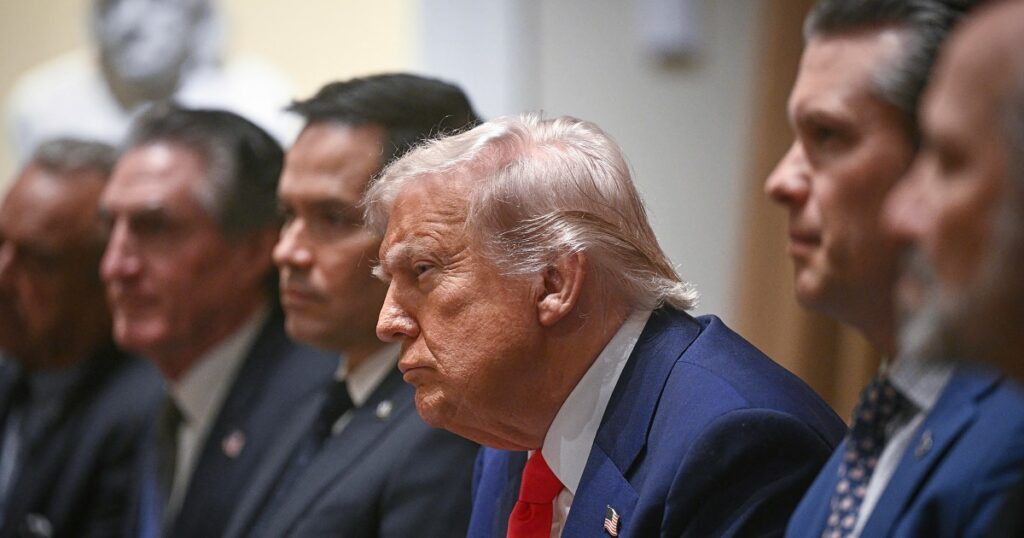WASHINGTON — The Oval Office meeting intended to discuss the new F-47 stealth fighter jet took an unexpected turn when Mark Zuckerberg, Meta’s chief executive, made an unannounced appearance. Concerns about security clearance led officials to ask Zuckerberg to wait outside, according to two sources familiar with the meeting. The session was further disrupted by a young aide showing President Donald Trump something on her laptop and by the president’s cellphone ringing multiple times. Expecting more privacy, the military leaders left the meeting feeling mystified and slightly unnerved, questioning whether the interruptions might have compromised sensitive information.
President Trump affectionately refers to the Oval Office as “Grand Central Terminal” due to its constant flow of visitors, a senior White House official revealed. In contrast, one participant described the meeting as a “bizarro world.” Despite attempts by various aides over the years to impose discipline, Trump’s preference for a freewheeling style prevails, reflecting his personality, according to current and former aides.
The Unorthodox West Wing
Trump’s management style is characterized by spontaneity. He often interrupts meetings to call friends or confidants, a senior administration official noted. Cabinet secretaries frequently roam the West Wing, engaging with powerful advisers like chief of staff Susie Wiles and deputy chief Stephen Miller. “No one wants to miss the decision,” said a frequent White House visitor. Meetings often extend beyond their scheduled time, with Trump inviting participants to stay longer.
While some view Trump’s approach as unorthodox, his supporters argue that it yields results. He is on the verge of passing a bill that aligns with many of his domestic priorities, including tax cuts and stricter immigration controls. Additionally, he brokered a ceasefire between Iran and Israel, preventing further escalation.
Risks and Rewards of Trump’s Style
However, Trump’s managerial style also presents risks. Cabinet secretaries, who oversee complex agencies, may neglect their responsibilities by spending excessive time at the White House. The flow of unvetted information from friends and associates can disrupt carefully prepared policy discussions. Unlike Grand Central Station, the White House is a place where secrets must be safeguarded.
NBC News interviewed over a dozen current and former administration officials, lawmakers, and Trump allies about the West Wing’s dynamics. They noted the informality, with one former national security official recalling frequent encounters with Vice President JD Vance near the Oval Office, enjoying coffee or cookies. Vance’s office declined to comment.
“He does what he wants, and they [Trump aides] let him do it,” said a Republican senator, speaking anonymously.
Cabinet Dynamics and Decision-Making
Under Trump’s leadership, Cabinet members are a constant presence in the West Wing. Secretary of State Marco Rubio, who also serves as national security adviser, has an office there, a dual role not seen since Henry Kissinger in the Nixon administration. Treasury Secretary Scott Bessent and Commerce Secretary Howard Lutnick are frequent visitors, with Lutnick described as a “perennial guest” due to his involvement in trade and tariff issues.
Face time with the president is crucial for Cabinet members to maintain influence. Trump’s first term saw high turnover, but his current Cabinet remains largely intact. “If you’re a Cabinet member, there’s a fine line between too much time and not enough time” with Trump, a senior administration official explained.
Wiles and the Balance of Power
Overseeing the West Wing is Susie Wiles, Trump’s fifth chief of staff. Known as the “Ice Maiden,” Wiles is credited with balancing Trump’s improvisational instincts with a semblance of order. Former House Speaker Newt Gingrich praised her as the best chief of staff Trump has had, noting her presence in important meetings and her ability to ensure Trump hears all sides of an issue before deciding.
Trump’s fondness for the cellphone remains a constant. He often pauses meetings to call friends like Dana White or Rupert Murdoch for advice, particularly on issues like the Israel-Iran conflict. Despite efforts by previous chiefs of staff, including John Kelly, to control access to Trump, Wiles has managed to maintain some structure while accommodating Trump’s preferences.
The White House deputy chief of staff for communications, Taylor Budowich, highlighted Trump’s Cabinet as the “greatest in American history,” emphasizing their role in implementing the president’s agenda. While Trump’s habits may not have changed much, his leadership style continues to shape the rhythms of the West Wing, with implications for both his administration and the broader political landscape.
